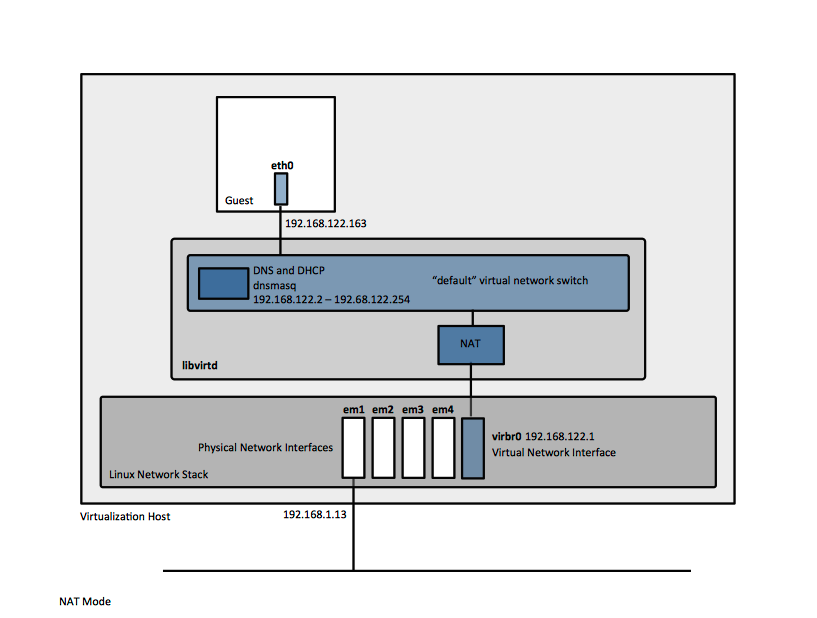KVM Virtual Networking Concepts: Difference between revisions
| Line 15: | Line 15: | ||
[[Linux Virtualization Concepts#libvirt|libvirt]] implements virtual networking using a ''virtual network switch''. A virtual network switch is a software component that runs on the virtualization host. The virtual machine guests connect to it and the network traffic to and from the guests passes through the virtual switch. | [[Linux Virtualization Concepts#libvirt|libvirt]] implements virtual networking using a ''virtual network switch''. A virtual network switch is a software component that runs on the virtualization host. The virtual machine guests connect to it and the network traffic to and from the guests passes through the virtual switch. | ||
The virtual switch is started and managed by the [[Libvirtd|libvirtd]] daemon and is represented as the '''virbr0'' network interface: | The virtual switch is started and managed by the [[Libvirtd|libvirtd]] daemon and is represented as the '''virbr0''' network interface: | ||
<pre> | <pre> | ||
# ip addr | |||
... | |||
7: virbr0: <BROADCAST,MULTICAST,UP,LOWER_UP> mtu 1500 qdisc noqueue state UP qlen 1000 | |||
link/ether 52:54:00:15:ef:87 brd ff:ff:ff:ff:ff:ff | |||
inet 192.168.122.1/24 brd 192.168.122.255 scope global virbr0 | |||
valid_lft forever preferred_lft forever | |||
... | |||
</pre> | </pre> | ||
==The DNS and DHCP Server== | ==The DNS and DHCP Server== | ||
Revision as of 17:15, 27 June 2017
External
Internal
Overview
This article discusses concepts related to virtual networking with libvirt.
Virtual Network Switch
libvirt implements virtual networking using a virtual network switch. A virtual network switch is a software component that runs on the virtualization host. The virtual machine guests connect to it and the network traffic to and from the guests passes through the virtual switch.
The virtual switch is started and managed by the libvirtd daemon and is represented as the virbr0 network interface:
# ip addr
...
7: virbr0: <BROADCAST,MULTICAST,UP,LOWER_UP> mtu 1500 qdisc noqueue state UP qlen 1000
link/ether 52:54:00:15:ef:87 brd ff:ff:ff:ff:ff:ff
inet 192.168.122.1/24 brd 192.168.122.255 scope global virbr0
valid_lft forever preferred_lft forever
...
The DNS and DHCP Server
The DNS and DHCP are both served by a dnsmasq instance running on the virtualization host. The configuration file is /var/lib/libvirt/dnsmasq/default.conf, but the configuration file should not be edited manually, but with
virsh net-edit default
Virtual Network Modes
NAT Mode
The NAT mode is the default mode in which KVM virtual networking gets deployed, without additional configuration.
Routed Mode
Bridged Mode
Isolated Mode
Organizatorium
A virtual machine guest that connects to an external network uses the software network components of the physical host, which are managed by libvirt's virtual network configuration. The host acts as a virtual network switch. By default, all guests on a single host are connected to the same virtual network, named "default". Guests have default direct IP connectivity to all other guests and to the host. libvirt network filtering and guest operating system iptables rules apply. Guests have external outbound access via NAT, subject to the host system's firewall rules. From the point of view of the guest operating system, a virtual network connection is the same as a normal physical network connection.
The guest network interfaces can be set to one of the following modes:
- isolated mode - the network won't allow any traffic beyond the virtualization host.
- routed mode - the network will route traffic between the guest and external hosts without performing any NAT. This enables incoming connections but requires extra routing table entries for the systems on the external network.
- bridged mode - the guests are connected to a bridge device that is also connected directly to a physical ethernet device connected to the local ethernet. This makes the quests directly visible on the physical network, and thus enables incoming connections, but does not require any extra routing table entries.
